Moose and elk might look so similar that you may find it difficult to distinguish between the two.
But are they the same? No.
Here are the 12 differences that make it easy to tell them apart. Check it out:
1. Size:
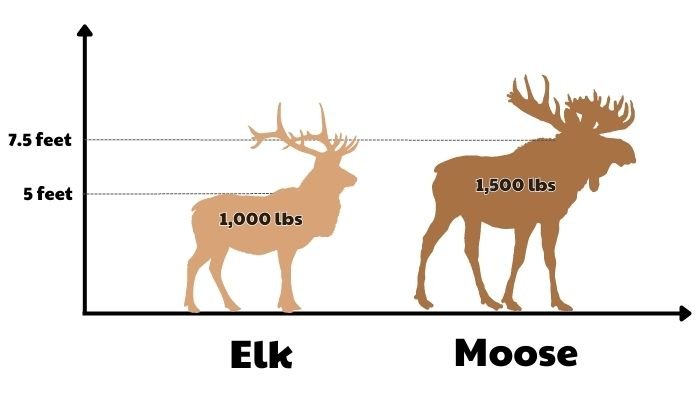
Moose are generally larger than elk.
Adult bull (male) moose can weigh up to 1500 pounds, while a bull elk weigh up to 1000 pounds.
In terms of height, moose are taller and have longer legs, with an average height of 6 to 7.5 feet at the shoulder, while elk are typically 4 to 5 feet tall at the shoulder.
Moose are also more massive animals, with a bulkier build and a more pronounced hump on their backs, compared to elk.
2. Nose:

Moose have a bulbous, elongated nose that hangs over their upper lip, called a "bell," which is covered in hair and can be used to scoop snow in search of food.
Elk, on the other hand, have a more pointed, narrow nose with a distinct "dip" between their nostrils.
Additionally, elk have a small patch of hair above their nostrils that moose lack.
3. Track:
Moose track ranges from 4.5 to 7 inches in length while elk track ranges from 4 to 4.8 inches.
This shows you that moose have a longer and larger track than elk.
Elk tracks tend to be more pointed with a heart-shaped imprint, while moose tracks are rounder with a wider imprint.


What is the advantage?
It is simply that moose are more likely to withstand cold climates than the elk due to their wider imprint.

Elk tracks often have a smaller stride length, indicating a quicker pace, whereas moose tracks show a longer stride length, suggesting a slower pace.
Elk tracks may also show signs of the animal's back hooves dragging, while moose tracks may show a slight indentation between the toe and the main track.
Moose and elk are both important game animals in North America.
4. Habitat:
Both moose and elk are members of the deer family.
Moose Habitat
You can easily find moose in wetlands and forested areas, particularly in northern regions with abundant lakes, streams, and bogs.
They prefer areas with dense vegetation, particularly willows and aspens, and are often found near bodies of water where they feed on aquatic plants.
Where do moose live in the US?
- Alaska
- New England (Northeastern region of the USA including: Connecticut, Maine, Massachusetts, New Hampshire, Rhode Island, and Vermont)
- And the Northern Rockies (particularly from Canada to the south-central USA).

Elk Habitat
On the other hand, elk are more commonly found in open grasslands and mountainous areas with mixed forests.
They tend to avoid densely wooded areas and are more adaptable to different types of terrain.
Where do elk live in the US?
- The Rocky Mountains of Colorado
- Wyoming
- South Dakota
- Nebraska
- Kansas
- The western region (particularly in Washington, Idaho, Utah, Oregon, California, and Hawaii).

5. Antlers:
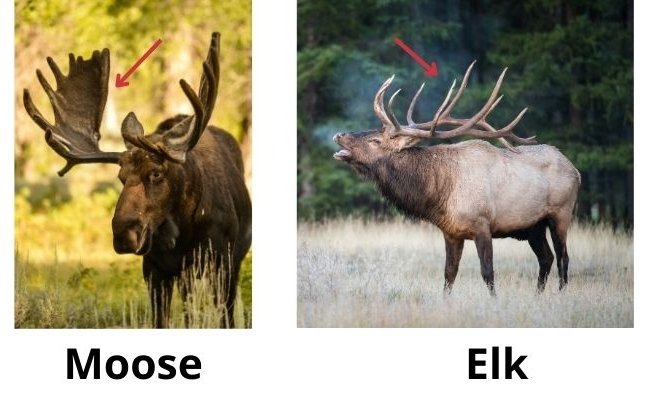
You'll notice that moose antlers are broad and flat with a palmate shape, resembling a hand with fingers spread wide.
They have large, rounded edges and can grow up 6 feet and weigh up to 40 pounds.
In contrast, elk antlers are more slender and pointed with many branches, forming a complex and often symmetrical shape.
They typically grow up to 4 feet and weigh between 10 and 20 pounds.
Additionally, elk antlers are shed annually in the spring, while moose antlers are shed in late fall or early winter.
6. Diet:
Moose are primarily browsers and feed on the leaves and twigs of trees and shrubs.
They prefer woody vegetation like willows and aspens and are known to wade into water to feed on aquatic plants.
On the other hand, elk are primarily grazers and feed on grasses and sedge.
They also browse on shrubs and trees, but grass makes up the majority of their diet.
7. Vocalization:
Elk and moose have distinct vocalizations that differ in tone, pitch, and purpose.
Elk produce a high-pitched bugle that can be heard for miles, particularly during mating season.
The bugle is a loud, piercing sound that is often accompanied by grunts and low-pitched calls.
In contrast, moose make a deep, guttural call that sounds like a low-pitched grunt or bellow.
This call is used primarily by males during the rut season to attract females and to warn other males of their presence.
8. Physical Appearance:
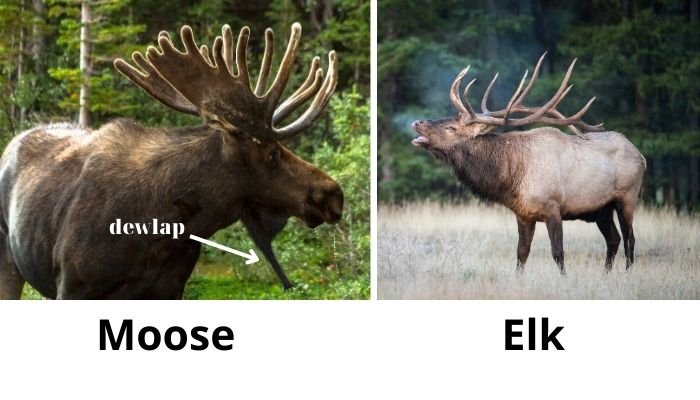
Elk are generally smaller than moose and have a lighter, more reddish-brown coat.
They also have a distinctive white rump patch and large antlers that branch upward and outward.
Moose, on the other hand, have a dark brown coat and a bulbous, protruding snout.
They also have a flap of skin, known as a dewlap or bell, that hangs beneath their throat and broad, flat antlers that resemble paddles.
9. Behavior:
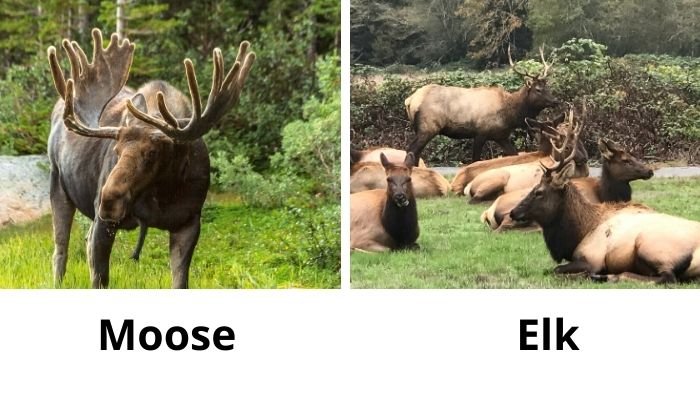
Elk and moose have different behaviors that reflect their distinct ecological roles.
Elk are social animals that typically form large herds, particularly during the mating season, males will often engage in vocal displays and physical combat to establish dominance.
You will always see elks in the daytime because they are majorly active during the day.
Moose, on the other hand, are more solitary and tend to be active at dawn and dusk.
They are excellent swimmers, often diving to feed on underwater plants.
Moose are also known for their aggressive behavior when threatened, especially during the mating season.
10. Mating:
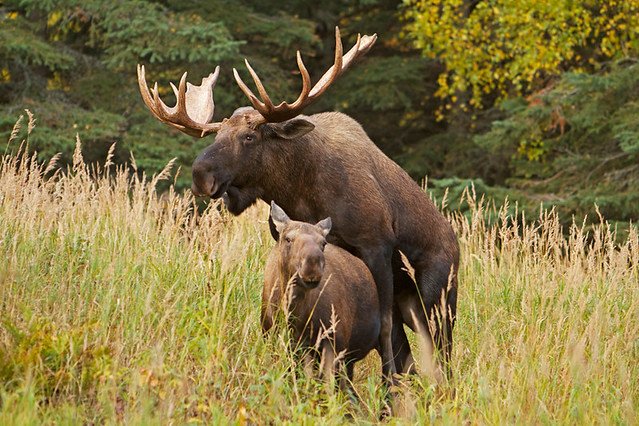
Male elk (bulls) typically form harems of females (cows) during the breeding season, and compete with other bulls for the right to mate with them.
In contrast, male moose (bulls) generally seek out individual females to mate with.
Additionally, moose have a shorter mating season than elk, typically lasting only a few weeks, while elk's breeding season can last several months.
Fun Fact: Moose is more aggressive than elk
This is due to the fact that the moose is a larger and more territorial animal than the elk.
Additionally, moose have a higher level of testosterone, which can increase their aggression.
Moose also inhabit dense forest, which can make them feel more vulnerable and defensive.
Finally, moose have a longer history of coexisting with humans, which may have led to learned aggressive behavior.
Watch this video to have a view of Alaska moose fighting 🙂
11. Gestation period:
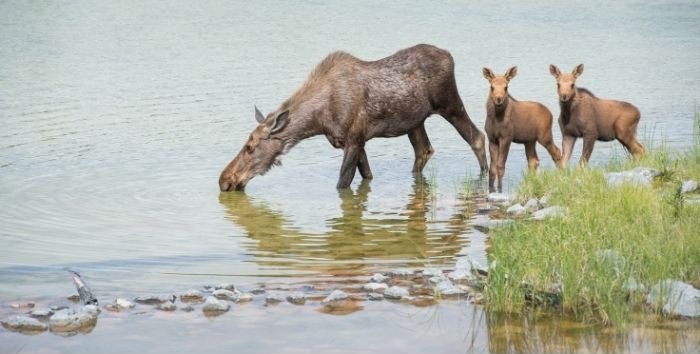
The gestation period is the length of time between conception and birth of an offspring.
In general, elk have a shorter gestation period than moose.
Elk have a gestation period of around 240 to 262 days (around 8 months), while moose have a gestation period of around 240 to 270 days.
However, it is important to note that gestation periods can vary depending on various factors such as age, health, and nutrition of the mother.
12. Lifespan:
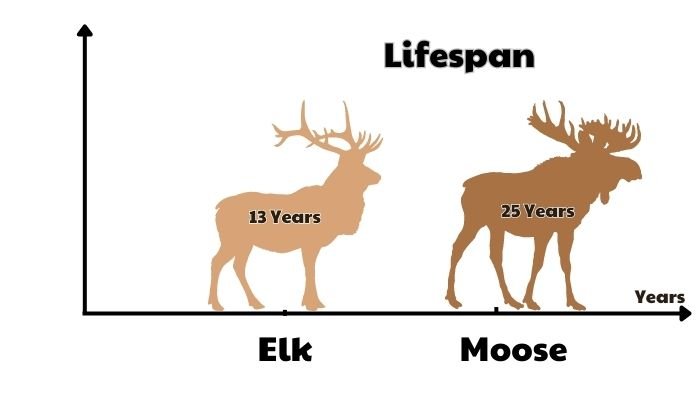
The average lifespan of an elk is about 10-13 years, although they can live up to 20 years in the wild.
Moose, on the other hand, have an average lifespan of 15-25 years, with some individuals living up to 30 years.
Therefore, moose tend to have a longer lifespan than elk.
Brief Difference:
The differences are summarized in the table below:
Difference | Elk | Moose |
|---|---|---|
Size | Typically 4 to 5 feet tall and weigh up to 1000 pounds | Average height of 6 to 7.5 feet and weigh up to 1500 pounds |
Nose | Elongated nose | Pointed and narrow nose |
Track | Wider inprint | More pointed inprint |
Habitat | Can be found in open grasslands and mountainous areas with mixed forests. | Can be found in wetlands and forested areas, particularly in northern regions. |
Diet | Feed on grasses and sedge | Feed on the leaves and twigs of trees and shrubs. |
Antlers | More slender and pointed with many branches. | Broad and flat with a palmate shape. |
Vocalization |
High-pitched bugle |
Guttural call that sounds deep |
Behavior |
Males will often engage in vocal displays and physical combat to establish dominance. |
Aggressive when threatened, especially during the mating period. |
Gestation period |
240 to 262 days |
240 to 270 days |
Appearance |
Light reddish-brown coat |
Dark brown coat and a bulbous, protruding snout |
Reproduction |
Male elk (bulls) typically form harems of females (cows) during the breeding season. |
Male moose (bulls) generally seek out individual females to mate with and have a shorter mating season than elk. |
Lifespan |
10-13 years |
15-25 years |
Final Thoughts:
It has been a nice journey:) and I believe you should be more enlightened on elk vs moose.
Curious to know more about elk hunting? Check it out here and find out how they are compared in their eukarya domain.
Happy hunting!

THIS IS SO GREAT
PLEASE CAN THIS WRITER WRITE AN ARTICLE ON (1.) caribou vs reindeer and (2.) Moose vs deer? ASAP!
PLEASE I REALLY LOVE HIS CONTENTS!!
Thanks, Jamzi